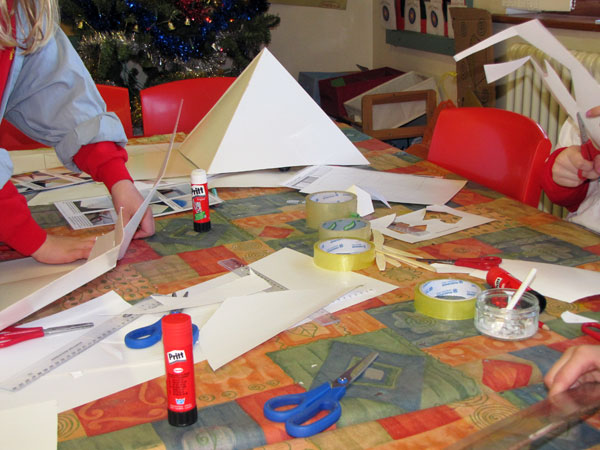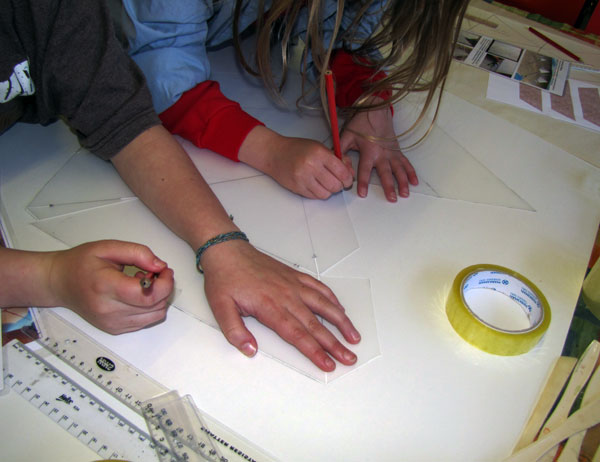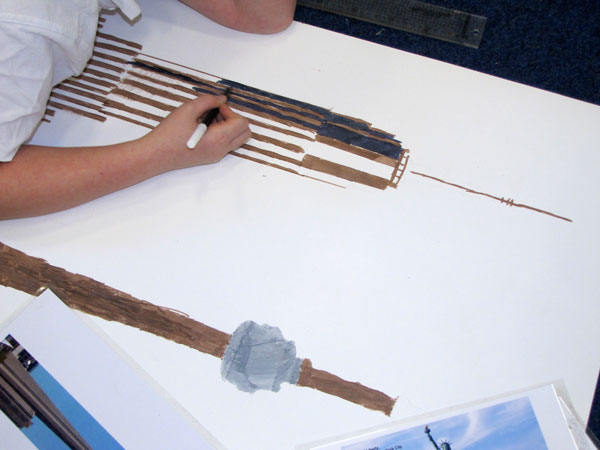Photos from the Second Pyramids Workshop
With a mixed year 5/6 class at Wrenbury Primary, near
Nantwich, December 2012. This was the first time any class had done the
full workshop, with the experimental archaeology in the morning and the
model building in the afternoon.
1. Making pyramids from blocks. One group managed to
make a 7 layer pyramid:

2. Ramp building.
One group here did a great job of their spiral ramp. They concluded that
it would have worked as a way of getting the blocks all the way to the
top of the pyramid.

3. Checking verticals and horizontals.
As an extension to checking lines and angles, some children
used the tools to draw vertical or horizontal lines. These tools would
have been used in this way to help cut the blocks accurately.

Afternoon activity: Making scale models of the pyramids

The children made a model of the Giza pyramids, in two versions - one as they are now, browned with age and 'bumpy', lacking their original casing stones, and one with the original casing which gave the pyramids a smooth, white appearance. The 'original' version also has the mortuary temples at the foot of each pyramid, the enclosure walls surrounding the pyramids, and the causeways leading away from the temples.
The models include the
queens' pyramids and the two tiny 'satellite' pyramids. In addition some
children made a card model of the Bent Pyramid, and some painted models of
the Step Pyramid, the Sphinx, and the Valley temple of Khafre next to
the Sphinx temple.
Also some children made cutout pictures of modern buildings to show
scale - including buildings smaller than the pyramids such as Buckingham
Palace, and huge skyscrapers which have held the record for world's
tallest building at some point, such as the CN Tower and the current
record holder, the Burj Khalifa. These buildings make a very striking
wall display, ideally positioned behind the pyramid model.
All the models are to the same scale - 1/560th - so they can be compared
to each other to give a sense of relative size (e.g. the Step Pyramid is
less than half the height of the Great Pyramid).

Making the base: Brushing glue onto corrugated cardboard, before gluing on another piece of cardboard.

After drawing on the positions of the pyramids
with a template, children used rollers to spread glue on the base, then
sprinkled sand on it.

Folding a card 'net' to make the casing for the Great Pyramid

Making the pyramid casings

Making the casings for the queens' pyramids

Using a template to make the Bent Pyramid

Making the mortuary temples

Making the 'old' version of Khafre's pyramid

Khafre's pyramid - fitting the smooth casing on the top

Painting the model of Khafre's valley temple and the sphinx temple

Drawing pictures of the Empire State Building and the CN Tower

Drawing the Eiffel Tower
The Finished Models

Pyramids of Giza, around 2400BC, with intact limestone casing and temples.


Pyramids of Giza, present day. From right to left, the main pyramids belonged to Khufu, Khafre and Menkaure.
The smaller pyramids belonged to their queens.

Khafre's valley temple (left), sphinx temple (right), and Great Sphinx.
Pink granite was used to cover the walls of parts of the temples.

Great Sphinx as originally painted

Bent Pyramid of Sneferu (father of Khufu), at Dahshur

Step Pyramid of Djoser - the first ever pyramid, about 2600BC

Model of the Great Pyramid in front of drawings of buildings: from left to right, Empire State Building (443m),
CN Tower (553m), Burj Khalifa (829m), World Trade Center 1 (526m), Eiffel Tower (300m when originally completed)